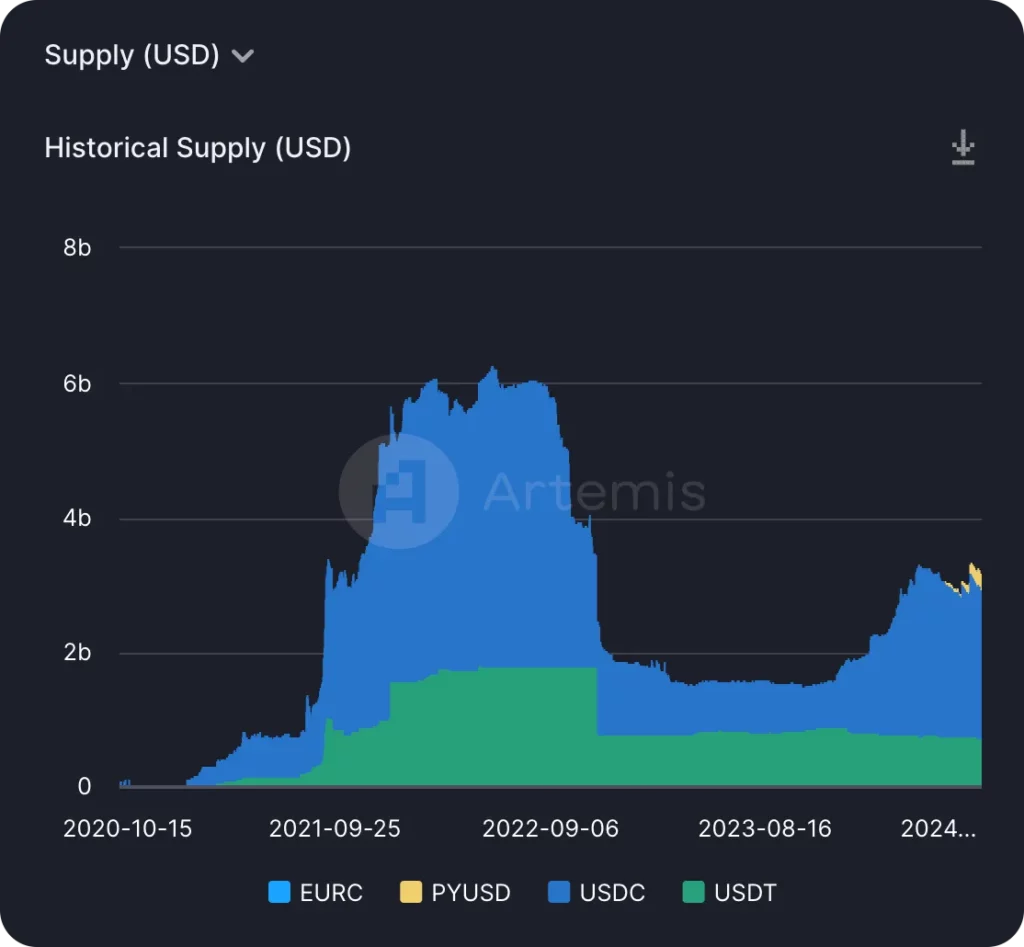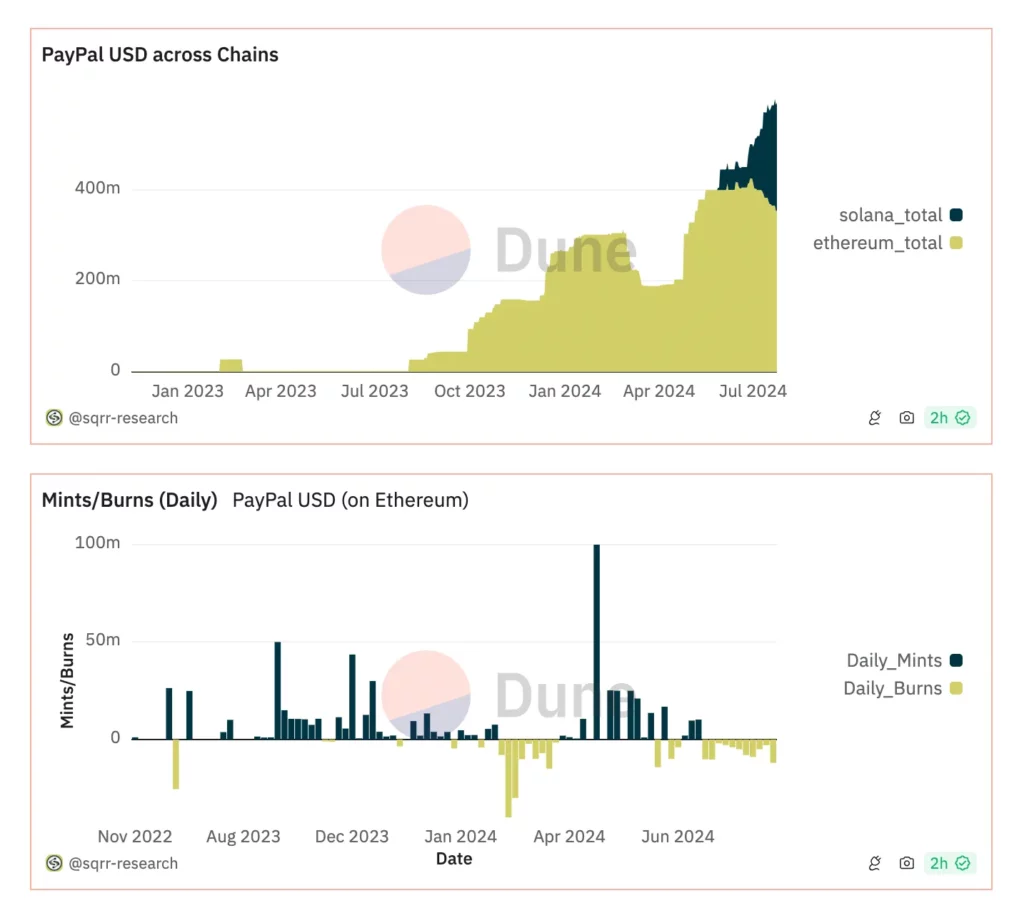How Are Stablecoins and RWAs Developing in the Solana Ecosystem?

With the recent surge in ETFs, stablecoins and Real World Assets (RWAs) have emerged as powerful means to enhance real-world adoption and strengthen the existing financial system through on-chain economics.
Larry Fink’s “tokenized world” mission has been one of the most discussed memes in this cycle, continuing this vision with Blackrock’s tokenized on-chain fund BUIDL. Despite Ethereum and Tron being the centers for stablecoins, Solana has shown exceptional performance, with peak daily trading volumes surpassing $100 billion.
RWA activities on the network are also increasing, with Ondo’s USDY as DeFi collateral, Maple Finance’s collaboration with Jito, and the launch of Libre Fund.
This article delves into these developments to understand Solana’s momentum in becoming one of the chains with the most real-world applications.
Stablecoins on Solana
Stablecoins on Solana have shown strong momentum and continued expansion this cycle, highlighting the network’s robustness and attractiveness to stablecoin issuers.
Today, Circle’s USDC dominates the stablecoin space on Solana, accounting for about 70% of the total stablecoin supply on the chain, despite holding only about 30% on Ethereum.
As of this week, despite USDT’s total market capitalization of $114 billion and Ethereum’s daily trading volume of $31.5 billion, surpassing the combined total of the top 20 ERC tokens, USDC’s trading volume compared to USDT (ranked second on-chain) is approximately 19:1. USDC’s dominance on Solana stems from Circle and Solana Foundation’s strategy to incentivize developers and promote platform integration.
For example, platforms like Solend and SuperTeam offer developer grants in USDC, attracting more developers to Solana. Circle’s launch of the Cross-Chain Transfer Protocol (CCTP) on Solana has also enhanced USDC’s availability and liquidity.
Additionally, Circle’s Web3 services simplify smart contract development, meeting developers’ needs and facilitating USDC integration. Overall, these efforts aim to unify DeFi and establish USDC as Solana’s leading stablecoin.

Ranked third is PayPal’s PYUSD, with a circulating supply of about $240 million, accounting for approximately 11% of Solana’s total stablecoin supply since its launch less than two months ago.
DeFi protocols like Kamino Finance have driven this growth by offering attractive supply-side yields for PYUSD starting July 1. These yields began at 30% and dropped to 23%, with borrowing APY at 0.22%, compared to USDC’s 21% and USDT’s 16.5%, making PYUSD an appealing DeFi tool. PYUSD’s supply increased by 88% in the week following July 1, with 38% flowing into Kamino.

Beyond stablecoin issuers, major financial platforms like Stripe and Shopify integrating with Solana open new opportunities for developers and businesses, enabling them to build trusted platforms that meet everyday needs and connect Solana with mainstream finance.
Projects like Sphere, Lulo, Decaf, and Helio are already in development, simplifying crypto transactions and using stablecoins like USDC to offer everyday financial services, such as converting to local currency, facilitating e-commerce crypto payments, and high-yield savings.
Overall, the momentum seen with stablecoins on Solana appears ready to expand the range of existing financial system products through efficient on-chain solutions.
RWAs on Solana
While the growth of RWAs on Solana is relatively quiet compared to Ethereum, Solana’s integration of real-world assets is building a fertile ecosystem beyond tokenized treasuries.
Ondo Finance’s flagship tokenized treasury product USDY was deployed on Solana in December 2023, with a current market cap of $42 million. Although relatively small compared to other leading stablecoins, USDY has made interesting progress, such as integration as collateral into the perps DEX Drift Protocol.
This and future collaborations add utility to tokenized real-world assets beyond lending, increasing traders’ capital efficiency.

Today, some of the most interesting RWA projects in the Solana ecosystem include Maple and Parcl.
Maple is a marketplace for whitelisted companies to borrow from on-chain liquidity pools, redeployed to Solana last year, offering yield channels for stablecoins and altcoins through an over-collateralized lending market.
Additionally, Maple has launched a new retail loan product, Syrup, in collaboration with Jito. This partnership provides flexible financing for borrowers using JitoSOL, unlocks yield sources for lenders, and enhances risk management through JitoSOL’s liquidity.
Parcl is a real estate perpetual DEX that allows users to invest and trade (long or short, up to 10x leverage) in specific geographic markets like Boston, Chicago, or Miami.
The protocol aims to democratize access to traditionally opaque asset classes for directional investments and hedging strategies. Parcl is also expanding into the forex space with upcoming GBP and EUR markets.

This is just the beginning of Solana’s RWA expansion, with the recently announced Libre Fund and the forthcoming GUM Alliance from Jupiter and elmnts exchange set to continue driving it forward.
Libre Fund
Libre, a joint venture between WebN Group under Brevan Howard and Laser Digital under Nomura, is launching a series of tokenized funds on Solana, such as the Hamilton Lane SCOPE Fund known for high yields and the Brevan Howard Master Fund focused on global macro trading strategies. Libre’s plans, with nearly $20 million in TVL before launch, include secondary trading services for its funds later this year.

Jupiter’s GUM Alliance
Jupiter’s Grand Unified Markets (GUM) initiative, in collaboration with the Solana Foundation and market makers like Wintermute and DWF Labs, aims to create a “single atomic market” on Jupiter for all assets, from forex and stocks to RWAs like credit, treasuries, and real estate, as well as cryptocurrencies.
This initiative intends to introduce tokenized assets effectively by ensuring deep liquidity and addressing the common “chicken or the egg” problem in tokenization, where issuers are reluctant to tokenize assets without liquidity, and liquidity remains low until more assets are tokenized.
Elmnts
Elmnts is an upcoming market for tokenized fundamental energy resources, such as mineral rights in the oil and gas industry, projected to generate over $800 billion in revenue in 2024. This approach enhances transparency, accessibility, and liquidity, addressing high transaction costs and low liquidity in current markets.
To this end, the company acquires mineral rights through auctions, private sales, and networks, with experts tracking active leasing areas and understanding oil and gas markets. This market simplifies the investment process, reduces costs, and allows more investors to participate with lower fees and minimums.
Conclusion
With significant growth in stablecoins and the stabilization of RWA products, Solana has laid a solid foundation for leveraging on-chain economics to expand real-world markets.
New and upcoming initiatives like Libre’s tokenized funds, Jupiter’s GUM Alliance, and elmnts’ fundamental energy resource market further embed Solana into the RWA market and provide broader access to on-chain real-world assets than most other chains.
Indeed, Coingecko’s recent report showed that the top 2 narratives in Q2 2024 were memecoins (of course) and RWAs. If Solana attracts as much attention to RWAs as memecoins, it could draw institutional capital to the chain and secure its leading position in this cycle’s trends.
As the existing financial system merges with decentralized finance, Solana’s role in facilitating the tokenization of traditional assets will continue to expand, cementing its status as a chain that meets all needs, whether retail or institutional.